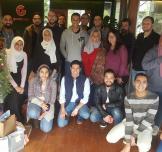Are you well Prepared? Your Guide to Hack4Egypt

Hack4Egypt Hackathon is for Technical entrepreneurs with technical prowess, designer, with creative flair and stellar design skills or business people with strong business acumen who have an initiative and want to contribute to the community and most importantly have a good English knowledge then this hackathon is definitely for you. But Hack4Egypt Techies did you prepare yourself? Well here are some articles which can guide your way to Hack4Egypt help you work on your idea, team and take an advantage of your mentors’ guidance.
Some like to think that it is the work of a lone genius, but that’s not true. Innovation mostly takes place when a person with an idea shares that idea with another person. When ideas are shared and combined, they lead to an innovative breakthrough.
Ideas seem to isolated dots, but in the right context, they can be related. BOM manages the creation and connection of these dots. The Business Opportunity Map (BOM) is an effective tool that companies can use to identify new fields of play, and eventually build complete business concepts. The BOM is comprised of five phases; Set-up, Diverge, Connect, Converge, and Emerge.
Teams are one of the main assets of any organization. Imagine people in a team working in different directions with different expectations, unable to work in harmony towards clear objectives. The results may not be aligned. The team charter acts as a roadmap for how the team should work together, empowering people to act towards a shared vision.
Mentors can do anything to help their mentees reach their goal. Read Ganesh Vancheeswaran’s, a Marketing professional, writer, and mentor to entrepreneurs, advice on how to take advantage of your mentors.
The Only 10 Slides You Need in Your Pitch
What do you do now that you have the audience’s attention? Guy Kawasaki, author, of 12 books and chief evangelist of Apple, preaches the “10/20/30 Rule of PowerPoint”. He believes that a pitch should have 10 slides, presented in 20 minutes with a font of 30 on each slide.
Kawasaki explains that no meeting should exceed ten concepts, thus the ten slides. He adds that even if you get an hour to give your presentation, 20 minutes is the optimal time. His reasoning is that the hour will be drained in setting up your computer and leaving time for discussion.






































































EgyptInnovate site is not responsible for the content of the comments